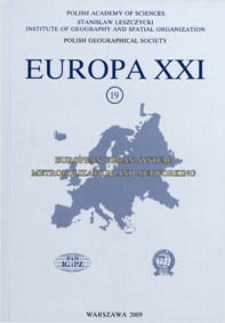
Obiekt
Tytuł: Evaluation of spatial categories and regional inequalities in the information age
Inny tytuł:
Wydawca:
Miejsce wydania:
Opis:
Typ obiektu:
Abstrakt:
By the appearance of the new innovations of information and communication technologies a transformation process has got started, which have changed our opinion on spatiality. Geographical features and inequality processes as well as the role of information fl ow and ICT infrastructure were altered modern spatial differences. This paper evaluates the spatial characteristics of the information economy and society, and emphasises new elements by the application of the terms of spatial sciences (e.g. space, place, distance etc.). It is also important to describe traditional and new features within the role that information economy and society or ICTs play in regional differences.
Bibliografia:
1. Atkinson, R. (1998), Technological change and cities. Cityscape: A Journal of Policy Development and Research, 3, 129–171.
2. Benedikt, M. (1991), Introduction, in: Benedikt, M (ed.) Cyberspace: first steps, MIT Press, Cambridge, Mass., USA, 1–25.
3. Brunn, S. D. and Leinbach, T. R. (eds) (1991), Collapsing space and time: geographic aspects of communication and information, Harper Collins Academic, New York, USA.
4. Cairncross, F. (1997), The death of distance. How the communication revolution will change our lives, Harvard Business School Press, Boston, USA.
5. Castells, M. (1996), The rise of the network society. The information age: economy, society and culture. Blackwell Publishers, Oxford.
6. Dodge, M. and Kitchin, R. (2001), Mapping cyberspace, Routledge, London.
7. Galácz A. and Molnár Sz. (2003), A magyarországi információs egyenlőtlenségek, in: Dessewffy, T. and Karvalics, Z. L. (eds.) Internet.hu—A magyar társadalom digitális gyorsfényképe, Aula Kiadó, 138–159.
8. Gorman, S. P. (2002), Where are the web factories: The urban bias of e-business location, Tijdschrifts voor Economische en Sociale Geografie, 5, 522–536.
http://dx.doi.org/10.1111/1467-9663.00223 -
9. Hauben, M. (1996), The net and the netizens: the impact the net has on people's lives, <http://www.columbia.edu/~rh120/ch106.x01, accessed 03.31.2009>.
10. Hayes, B. (1997), The infrastructure of the information infrastructure, American Scientist, 3, 214–218.
11. Huws, U. (2002), The persistence of national differences in the new global division of labour in e-services', Globalisation, Innovation and Human Development for Competitive Advantage, Asia Institute of Technology, Bangkok.
12. Johansson, T. D. (2000), Visualization in cyber-geography: reconsidering cartography's concept of visualization in current user-centric cyber-geographic cosmologies, Working Paper, 17, Centre for Advanced Spatial Analysis, University College London, London.
13. Kitchin, R. M. (1998), Towards geographies of cyberspace, Progress in Human Geography, 3, 385–406.
http://dx.doi.org/10.1191/030913298668331585 -
14. Krugman, P. (1999), The role of geography in development, International Regional Science Review, 2, 142–161.
http://dx.doi.org/10.1177/016001799761012307 -
15. Mitchell, W. (1995), City of bits: space, place, and the Infobahn, MIT Press, Cambridge, Mass., USA.
16. Molnár Sz. (2002), A digitális megosztottság értelmezési kerete, Információs Társadalom, 4, 82–101.
17. Morgan, K. (2001), The exaggerated death of geography: localised learning, innovation and uneven development, The Future of Innovation Studies Conference, The Eindhoven Centre for Innovation Studies, Eindhoven University of Technology.
18. Negroponte, N. (1995), Being digital, Coronet, London.
19. O'Brien, R. (1992), Global financial integration: the end of geography, Council of Foreign Relations, New York.
20. Ohmae, K. (1990), The borderless world, Harper, New York.
21. Ruttkay, É. (1992), Az információgazdaság térbeli terjedésének néhány jellemzője hazánkban, Kutatásszervezési Tájékoztató, 2/3, 109–119.
22. Stone, A. R. (1991), Will the real body please stand up? Boundary stories about virtual cultures, in: Benedikt, M (ed.) Cyberspace: first steps, MIT Press, Cambridge, Mass., USA, 81–118.
23. Storper, M. (1997), The regional world, Guilford Press, New York, USA.
Czasopismo/Seria/cykl:
Tom:
Strona pocz.:
Strona końc.:
Szczegółowy typ zasobu:
Format:
Rozmiar pliku 0,7 MB ; application/pdf
Identyfikator zasobu:
oai:rcin.org.pl:55825 ; 1429-7132 ; 10.7163/Eu21.2008.19.7
Źródło:
CBGiOŚ. IGiPZ PAN, sygn.: Cz.6406, Cz.6407 ; kliknij tutaj, żeby przejść
Język:
Prawa:
Prawa zastrzeżone - dostęp nieograniczony
Zasady wykorzystania:
Digitalizacja:
Instytut Geografii i Przestrzennego Zagospodarowania Polskiej Akademii Nauk
Lokalizacja oryginału:
Dofinansowane ze środków:
Unia Europejska. Europejski Fundusz Rozwoju Regionalnego ; Program Operacyjny Innowacyjna Gospodarka, lata 2010-2014, Priorytet 2. Infrastruktura strefy B + R
Dostęp:
Kolekcje, do których przypisany jest obiekt:
- Instytut Geografii i Przestrzennego Zagospodarowania PAN > Publikacje pracowników i Wydawnictw
- Instytut Geografii i Przestrzennego Zagospodarowania PAN > Biblioteka Instytutu > Serie/Czasopisma/Cykle
Data ostatniej modyfikacji:
25 mar 2021
Data dodania obiektu:
14 sie 2015
Liczba pobrań / odtworzeń:
919
Wszystkie dostępne wersje tego obiektu:
https://www.rcin.org.pl/igipz/publication/75510
Wyświetl opis w formacie RDF:
Wyświetl opis w formacie RDFa:
Wyświetl opis w formacie OAI-PMH:
| Nazwa wydania | Data |
|---|---|
| Ákos J. - Evaluation of spatial categories and regional inequalities in the information age | 25 mar 2021 |

 INSTYTUT ARCHEOLOGII I ETNOLOGII POLSKIEJ AKADEMII NAUK
INSTYTUT ARCHEOLOGII I ETNOLOGII POLSKIEJ AKADEMII NAUK
 INSTYTUT BADAŃ LITERACKICH POLSKIEJ AKADEMII NAUK
INSTYTUT BADAŃ LITERACKICH POLSKIEJ AKADEMII NAUK
 INSTYTUT BADAWCZY LEŚNICTWA
INSTYTUT BADAWCZY LEŚNICTWA
 INSTYTUT BIOLOGII DOŚWIADCZALNEJ IM. MARCELEGO NENCKIEGO POLSKIEJ AKADEMII NAUK
INSTYTUT BIOLOGII DOŚWIADCZALNEJ IM. MARCELEGO NENCKIEGO POLSKIEJ AKADEMII NAUK
 INSTYTUT BIOLOGII SSAKÓW POLSKIEJ AKADEMII NAUK
INSTYTUT BIOLOGII SSAKÓW POLSKIEJ AKADEMII NAUK
 INSTYTUT CHEMII FIZYCZNEJ PAN
INSTYTUT CHEMII FIZYCZNEJ PAN
 INSTYTUT CHEMII ORGANICZNEJ PAN
INSTYTUT CHEMII ORGANICZNEJ PAN
 INSTYTUT FILOZOFII I SOCJOLOGII PAN
INSTYTUT FILOZOFII I SOCJOLOGII PAN
 INSTYTUT GEOGRAFII I PRZESTRZENNEGO ZAGOSPODAROWANIA PAN
INSTYTUT GEOGRAFII I PRZESTRZENNEGO ZAGOSPODAROWANIA PAN
 INSTYTUT HISTORII im. TADEUSZA MANTEUFFLA POLSKIEJ AKADEMII NAUK
INSTYTUT HISTORII im. TADEUSZA MANTEUFFLA POLSKIEJ AKADEMII NAUK
 INSTYTUT JĘZYKA POLSKIEGO POLSKIEJ AKADEMII NAUK
INSTYTUT JĘZYKA POLSKIEGO POLSKIEJ AKADEMII NAUK
 INSTYTUT MATEMATYCZNY PAN
INSTYTUT MATEMATYCZNY PAN
 INSTYTUT MEDYCYNY DOŚWIADCZALNEJ I KLINICZNEJ IM.MIROSŁAWA MOSSAKOWSKIEGO POLSKIEJ AKADEMII NAUK
INSTYTUT MEDYCYNY DOŚWIADCZALNEJ I KLINICZNEJ IM.MIROSŁAWA MOSSAKOWSKIEGO POLSKIEJ AKADEMII NAUK
 INSTYTUT PODSTAWOWYCH PROBLEMÓW TECHNIKI PAN
INSTYTUT PODSTAWOWYCH PROBLEMÓW TECHNIKI PAN
 INSTYTUT SLAWISTYKI PAN
INSTYTUT SLAWISTYKI PAN
 SIEĆ BADAWCZA ŁUKASIEWICZ - INSTYTUT TECHNOLOGII MATERIAŁÓW ELEKTRONICZNYCH
SIEĆ BADAWCZA ŁUKASIEWICZ - INSTYTUT TECHNOLOGII MATERIAŁÓW ELEKTRONICZNYCH
 MUZEUM I INSTYTUT ZOOLOGII POLSKIEJ AKADEMII NAUK
MUZEUM I INSTYTUT ZOOLOGII POLSKIEJ AKADEMII NAUK
 INSTYTUT BADAŃ SYSTEMOWYCH PAN
INSTYTUT BADAŃ SYSTEMOWYCH PAN
 INSTYTUT BOTANIKI IM. WŁADYSŁAWA SZAFERA POLSKIEJ AKADEMII NAUK
INSTYTUT BOTANIKI IM. WŁADYSŁAWA SZAFERA POLSKIEJ AKADEMII NAUK
































